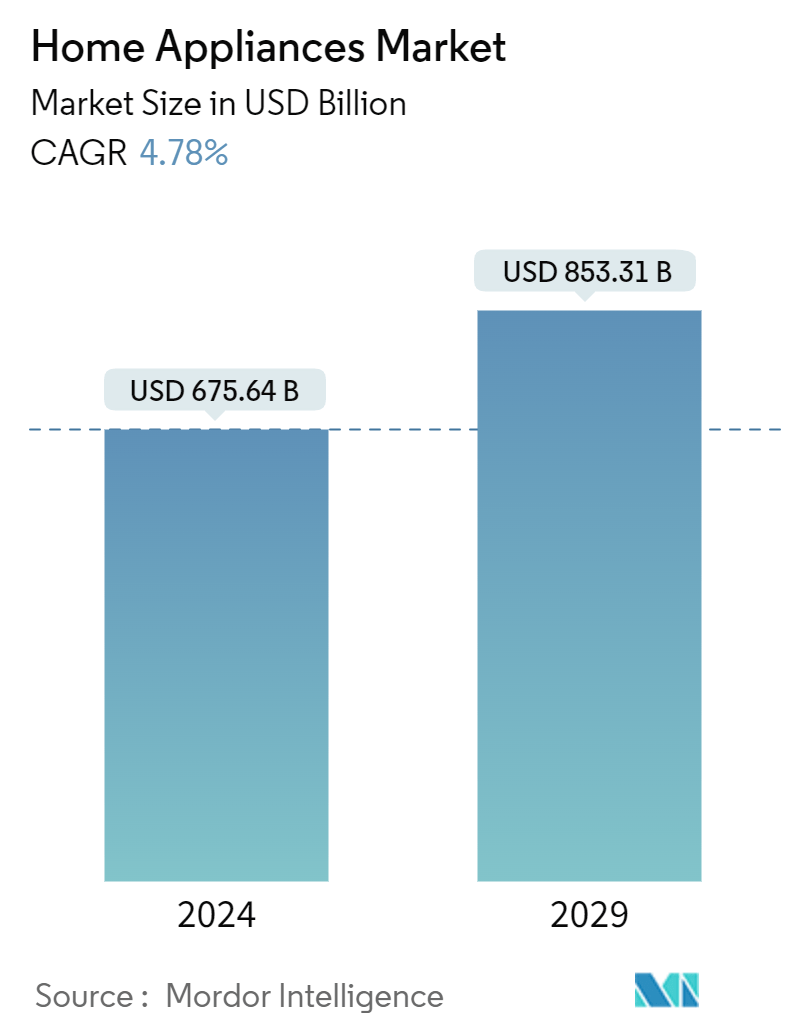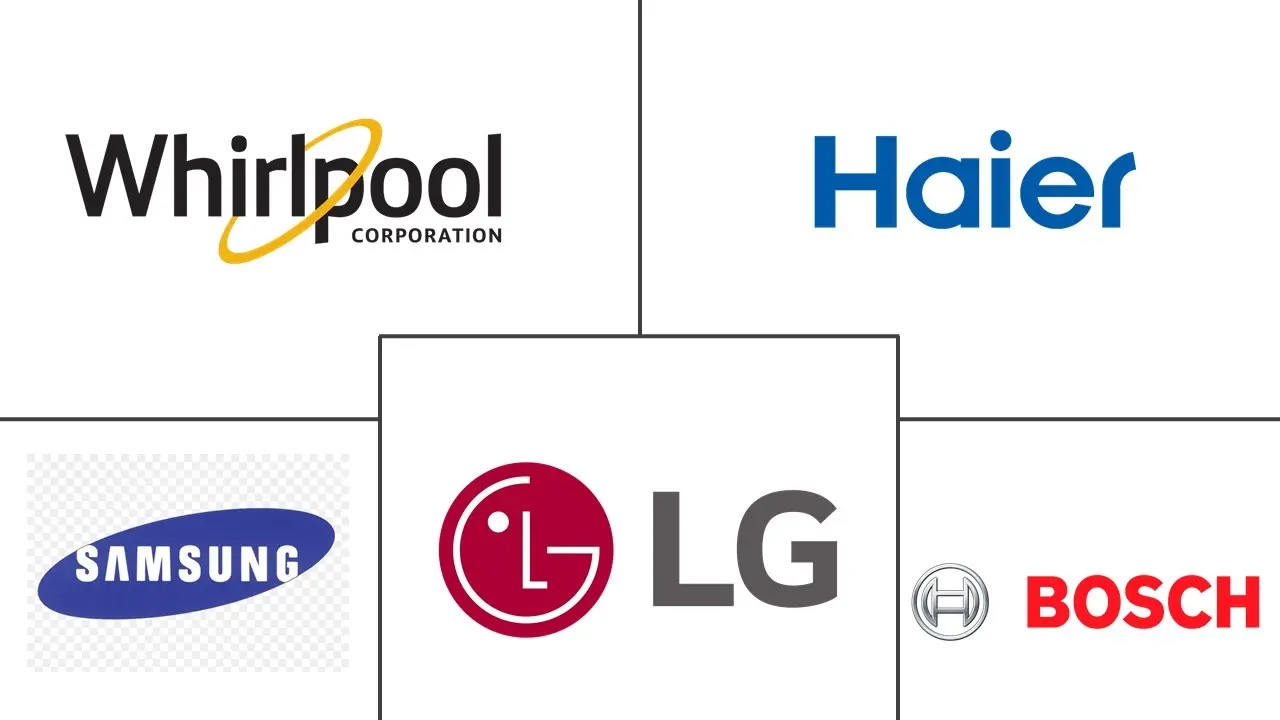Market Size of Home Appliances Industry

| Study Period | 2020 - 2029 |
| Market Size (2024) | USD 675.64 Billion |
| Market Size (2029) | USD 853.31 Billion |
| CAGR (2024 - 2029) | 4.78 % |
| Fastest Growing Market | North America |
| Largest Market | Asia Pacific |
Major Players
*Disclaimer: Major Players sorted in no particular order |
Home Appliances Market Analysis
The Home Appliances Market size is estimated at USD 675.64 billion in 2024, and is expected to reach USD 853.31 billion by 2029, at a CAGR of 4.78% during the forecast period (2024-2029).
The home appliance market has experienced consistent growth in recent years and is expected to maintain this upward trajectory in the next decade. The transition from traditional to smart home appliances is seen as a revolutionary development in the home appliance sector. The primary drivers of the market are a rise in per capita income, a shift in consumer lifestyle, and an increasing number of smaller homes. Moreover, customer preference for eco-friendly and energy-efficient appliances drives market expansion. Furthermore, factors such as government programs for energy-efficient appliances in the world are likely to boost energy-efficient appliance adoption in the coming years.
Consumers have grown more tech-savvy as a result of increased digitization, and they are well-versed in the usage and advantages of all modern products. With technological advancement, the number of smart appliances launched on the market has gradually grown. The growth of smart appliances, which can be connected to a smartphone and monitored remotely, is being aided by the rise of smart homes and smartphones.
Manufacturers of wireless technologies, such as Wi-Fi and Bluetooth, leverage connection as a distinctive feature that may be employed in or accessible by smartphones and tablets. Yet, manufacturers are attracting tech-savvy consumers by incorporating this technology into residential home appliances such as air conditioners, refrigerators, ovens, washing machines, and other appliances. The enhancement of network infrastructure has led to improved broadband and internet accessibility. As a result, consumers are increasingly selecting wireless and technologically advanced products, primarily due to the convenience they provide. The affordability of white goods ownership, especially in developing countries, also presents growth opportunities in the market. Additionally, an increase in replacement sales in developed regions is projected to boost market demand, which can be attributed to rising per capita income and rapid urbanization.
Home Appliances Industry Segmentation
A household appliance is a domestic appliance, an electric appliance, or a home appliance, is a device that aids in household tasks like cooking, cleaning, and food preservation. The report provides a thorough examination of the home appliances market, encompassing an evaluation of national accounts, economic factors, and emerging trends within different segments. It also delves into the notable shifts in market dynamics and offers an overview of the market as a whole.
The home appliance market is segmented by product (major appliances (refrigerators, freezers, dishwashers, ovens, air conditioners, and other major appliances) and small appliances (coffee and tea makers, food processors, grills and roasters, vacuum cleaners, and other small appliances)), distribution channel (multi-branded stores, specialty stores, online, and other distribution channels), and geography (North America, South America, Europe, Asia-Pacific, and the Middle East and Africa). The report provides market size and value forecasts (in USD) for these segments.
| By Product | |||||||||
| |||||||||
|
| By Distribution Channel | |
| Multi-Branded Stores | |
| Specialty Stores | |
| Online | |
| Other Distribution Channels |
| North America | |
| United States | |
| Canada | |
| Mexico | |
| Rest of North America |
| Europe | |
| United Kingdom | |
| Germany | |
| France | |
| Russia | |
| Italy | |
| Spain | |
| Rest of Europe |
| Asia-Pacific | |
| India | |
| China | |
| Japan | |
| Australia | |
| Rest of Asia-Pacific |
| South America | |
| Brazil | |
| Argentina | |
| Rest of South America |
| Middle East and Africa | |
| United Arab Emirates | |
| South Africa | |
| Rest of Middle East and Africa |
Home Appliances Market Size Summary
The home appliance market is on a steady growth trajectory, driven by the transition from traditional to smart appliances and the increasing demand for eco-friendly and energy-efficient products. Factors such as rising per capita income, changing consumer lifestyles, and the trend towards smaller living spaces are contributing to this expansion. The market is also benefiting from the growing digitization and tech-savviness of consumers, who are increasingly adopting smart appliances that offer connectivity and convenience. The enhancement of network infrastructure and the affordability of white goods in developing countries further support market growth. Additionally, the replacement sales in developed regions, fueled by urbanization and rising disposable incomes, are expected to boost demand for home appliances.
The small home appliances segment is anticipated to experience significant growth, driven by increased consumer spending and urbanization. As urban residents adopt these appliances at higher rates, the demand for products like coffee makers and food processors is expected to rise. The Asia-Pacific region is poised to lead the market, with countries like India, China, and Japan driving demand due to urbanization and construction activities. The presence of local players offering affordable products and the popularity of online sales are also contributing to market expansion. The market is highly fragmented, with major players like Whirlpool, Haier, Samsung Electronics, LG Electronics, and Bosch dominating, while smaller enterprises are gaining traction through innovation and new market entries.
Home Appliances Market Size - Table of Contents
-
1. MARKET INSIGHTS AND DYNAMICS
-
1.1 Market Overview
-
1.2 Market Drivers
-
1.2.1 Increasing Adoption of Connected Home Appliances for Convenience and Automation
-
1.2.2 Growth in Disposable Income Levels and Consumer Spending
-
-
1.3 Market Restraints
-
1.3.1 Changing Consumer Preferences and Lifestyle Trends Influencing Demand for Certain Appliances
-
1.3.2 Regulatory Compliances Impedes Market Growth
-
-
1.4 Market Opportunities
-
1.4.1 Integration of Smart Home Technology, such as IoT and Voice Control, in Appliances
-
-
1.5 Value Chain/Supply Chain Analysis
-
1.6 Porter's Five Forces Analysis
-
1.6.1 Bargaining Power of Suppliers
-
1.6.2 Bargaining Power of Buyers/Consumers
-
1.6.3 Threat of New Entrants
-
1.6.4 Threat of Substitute Products
-
1.6.5 Intensity of Competitive Rivalry
-
-
1.7 Insights on Technological Advancements in the Market
-
1.8 Impact of COVID-19 on the Market
-
-
2. MARKET SEGMENTATION
-
2.1 By Product
-
2.1.1 Major Appliances
-
2.1.1.1 Refrigerators
-
2.1.1.2 Freezers
-
2.1.1.3 Dishwashing Machines
-
2.1.1.4 Washing Machines
-
2.1.1.5 Ovens
-
2.1.1.6 Air Conditioners
-
2.1.1.7 Other Major Appliances
-
-
2.1.2 Small Appliances
-
2.1.2.1 Coffee/Tea Makers
-
2.1.2.2 Food Processors
-
2.1.2.3 Grills and Roasters
-
2.1.2.4 Vacuum Cleaners
-
2.1.2.5 Other Small Appliances
-
-
-
2.2 By Distribution Channel
-
2.2.1 Multi-Branded Stores
-
2.2.2 Specialty Stores
-
2.2.3 Online
-
2.2.4 Other Distribution Channels
-
-
2.3 By Geography
-
2.4 North America
-
2.4.1 United States
-
2.4.2 Canada
-
2.4.3 Mexico
-
2.4.4 Rest of North America
-
-
2.5 Europe
-
2.5.1 United Kingdom
-
2.5.2 Germany
-
2.5.3 France
-
2.5.4 Russia
-
2.5.5 Italy
-
2.5.6 Spain
-
2.5.7 Rest of Europe
-
-
2.6 Asia-Pacific
-
2.6.1 India
-
2.6.2 China
-
2.6.3 Japan
-
2.6.4 Australia
-
2.6.5 Rest of Asia-Pacific
-
-
2.7 South America
-
2.7.1 Brazil
-
2.7.2 Argentina
-
2.7.3 Rest of South America
-
-
2.8 Middle East and Africa
-
2.8.1 United Arab Emirates
-
2.8.2 South Africa
-
2.8.3 Rest of Middle East and Africa
-
-
Home Appliances Market Size FAQs
How big is the Home Appliances Market?
The Home Appliances Market size is expected to reach USD 675.64 billion in 2024 and grow at a CAGR of 4.78% to reach USD 853.31 billion by 2029.
What is the current Home Appliances Market size?
In 2024, the Home Appliances Market size is expected to reach USD 675.64 billion.

